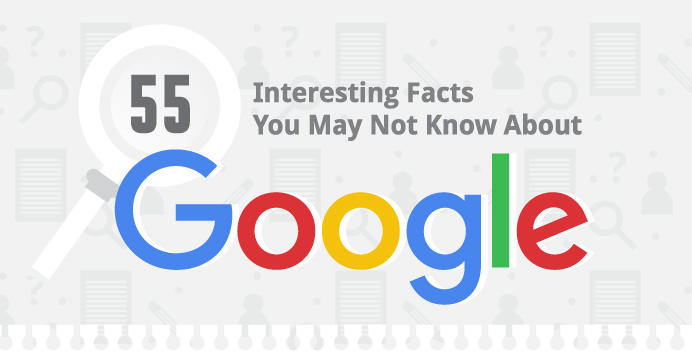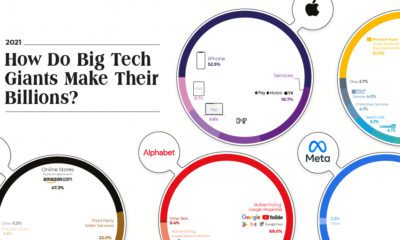The domain was registered in 1997 by Larry Page and Sergey Brin, and the company was incorporated in 1998. The “Google Guys” worked out of a garage in Menlo Park, California, with a simple but ambitious mission: to organize the seemingly unlimited amounts of information scattered throughout the web. It’s almost twenty years later, and we now know that Google’s monetization of search has changed the world. The company basically mints cash for investors each quarter, and this gives Alphabet the leeway from Wall Street to take an unprecedented amount of moonshots to find its next cash cow. And while the vast majority of people are aware of Google’s success, there are also some things that are less widely known about the company and its history.
55 Facts You May Not Know About Google
The following infographic from BargainFox shares 55 facts on Google, including some that you may not have heard before.
While many have heard that Google was started in a garage (like various other billion dollar tech companies), it is less clear that the garage was owned by Susan Wojcicki, who is now the CEO of Youtube. Likewise, it is widely known that the name Google was based off of the number “googol”, which is represented by numeral one and then followed by some 100 zeros. However, many people don’t realize that this number is symbolic: it represents the almost infinite amount of individual web pages on the internet, which Google aims to organize. Lastly, while most advertisers are aware that some search terms are likely to cost more on Google, many do not know the crazy world of ultra-specific legal keywords. Terms like “San Antonio car wreck attorney” and “West Palm Beach criminal lawyer” are the most expensive search phrases to sponsor on Google. By recent accounts, the most expensive search term these days is “best mesothelioma lawyers” which costs $194.40 per individual click. Law firms are willing to pay for leads, because mesothelioma is a very rare form of cancer caused by exposure to asbestos. Victims suffering from the disease are entitled to receive $1.1 million in compensation from the government within 30 days of their claim’s approval, and as a result, the cases can be very lucrative for lawyers.
on But fast forward to the end of last week, and SVB was shuttered by regulators after a panic-induced bank run. So, how exactly did this happen? We dig in below.
Road to a Bank Run
SVB and its customers generally thrived during the low interest rate era, but as rates rose, SVB found itself more exposed to risk than a typical bank. Even so, at the end of 2022, the bank’s balance sheet showed no cause for alarm.
As well, the bank was viewed positively in a number of places. Most Wall Street analyst ratings were overwhelmingly positive on the bank’s stock, and Forbes had just added the bank to its Financial All-Stars list. Outward signs of trouble emerged on Wednesday, March 8th, when SVB surprised investors with news that the bank needed to raise more than $2 billion to shore up its balance sheet. The reaction from prominent venture capitalists was not positive, with Coatue Management, Union Square Ventures, and Peter Thiel’s Founders Fund moving to limit exposure to the 40-year-old bank. The influence of these firms is believed to have added fuel to the fire, and a bank run ensued. Also influencing decision making was the fact that SVB had the highest percentage of uninsured domestic deposits of all big banks. These totaled nearly $152 billion, or about 97% of all deposits. By the end of the day, customers had tried to withdraw $42 billion in deposits.
What Triggered the SVB Collapse?
While the collapse of SVB took place over the course of 44 hours, its roots trace back to the early pandemic years. In 2021, U.S. venture capital-backed companies raised a record $330 billion—double the amount seen in 2020. At the time, interest rates were at rock-bottom levels to help buoy the economy. Matt Levine sums up the situation well: “When interest rates are low everywhere, a dollar in 20 years is about as good as a dollar today, so a startup whose business model is “we will lose money for a decade building artificial intelligence, and then rake in lots of money in the far future” sounds pretty good. When interest rates are higher, a dollar today is better than a dollar tomorrow, so investors want cash flows. When interest rates were low for a long time, and suddenly become high, all the money that was rushing to your customers is suddenly cut off.” Source: Pitchbook Why is this important? During this time, SVB received billions of dollars from these venture-backed clients. In one year alone, their deposits increased 100%. They took these funds and invested them in longer-term bonds. As a result, this created a dangerous trap as the company expected rates would remain low. During this time, SVB invested in bonds at the top of the market. As interest rates rose higher and bond prices declined, SVB started taking major losses on their long-term bond holdings.
Losses Fueling a Liquidity Crunch
When SVB reported its fourth quarter results in early 2023, Moody’s Investor Service, a credit rating agency took notice. In early March, it said that SVB was at high risk for a downgrade due to its significant unrealized losses. In response, SVB looked to sell $2 billion of its investments at a loss to help boost liquidity for its struggling balance sheet. Soon, more hedge funds and venture investors realized SVB could be on thin ice. Depositors withdrew funds in droves, spurring a liquidity squeeze and prompting California regulators and the FDIC to step in and shut down the bank.
What Happens Now?
While much of SVB’s activity was focused on the tech sector, the bank’s shocking collapse has rattled a financial sector that is already on edge.
The four biggest U.S. banks lost a combined $52 billion the day before the SVB collapse. On Friday, other banking stocks saw double-digit drops, including Signature Bank (-23%), First Republic (-15%), and Silvergate Capital (-11%).
Source: Morningstar Direct. *Represents March 9 data, trading halted on March 10.
When the dust settles, it’s hard to predict the ripple effects that will emerge from this dramatic event. For investors, the Secretary of the Treasury Janet Yellen announced confidence in the banking system remaining resilient, noting that regulators have the proper tools in response to the issue.
But others have seen trouble brewing as far back as 2020 (or earlier) when commercial banking assets were skyrocketing and banks were buying bonds when rates were low.

















